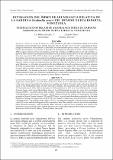Por favor, use este identificador para citar o enlazar este ítem:
https://hdl.handle.net/20.500.12958/3447Registro completo de metadatos
| Campo DC | Valor | Lengua/Idioma |
|---|---|---|
| dc.contributor.author | González C., Leo Walter | - |
| dc.contributor.author | Núñez, Eduardo | - |
| dc.contributor.author | Eslava, Nora | - |
| dc.contributor.author | Guevara, Francisco | - |
| dc.contributor.editor | Instituto del Mar del Perú | - |
| dc.date.accessioned | 2020-09-03T16:19:19Z | - |
| dc.date.available | 2020-09-03T16:19:19Z | - |
| dc.date.issued | 2020 | - |
| dc.identifier.citation | Bol Inst Mar Perú. 35(1) 2020, p.127-133 | es_ES |
| dc.identifier.isbn | 04587766 | - |
| dc.identifier.uri | https://hdl.handle.net/20.500.12958/3447 | - |
| dc.description.abstract | La pesquería de peces pelágicos menores en Venezuela está constituida fundamentalmente por la sardina (Sardinella aurita), cuyos núcleos de abundancia se presentan en las costas de los estados nororientales de Sucre y Nueva Esparta. En 2004 la captura máxima en Nueva Esparta fue de 107 mil toneladas, en 2005 disminuyó a 36 mil toneladas y a partir de 2006 comenzó una disminución drástica con fluctuaciones anuales entre 1 y 8 mil toneladas durante diez años. A partir de 2016 y 2017 se observó un apreciable aumento de 300% ≈. En este contexto y con el fin de entender la evolución espacio-temporal de la biomasa pescable, se estimó el índice de abundancia relativa mensual y anual de la sardina en 33 caladeros de Nueva Esparta durante el periodo 2010-2017, con base en datos de captura y esfuerzo proporcionados por el Instituto Socialista de Pesca y Acuicultura (INSOPESCA) sede Salamanca, y entrevistas a propietarios de las unidades de pesca. La captura por unidad de esfuerzo (CPUEi) se calculó según la ecuación de Gulland, relacionando la captura (Ci) en toneladas y el esfuerzo de pesca (Ei) en número de lances. Los valores mensuales del índice de abundancia relativa evidenciaron estacionalidad, y los anuales presentaron tendencia ascendente, posiblemente, debido a la veda temporal implementada en 2014 y las condiciones ambientales favorables que beneficiaron el reclutamiento. | es_ES |
| dc.description.abstract | ABSTRAC: The sardine (Sardinella aurita) is one of the main species targeted by the fisheries for small pelagic fish in Venezuela and is abundant along the coasts of the northeastern states of Sucre and Nueva Esparta. The maximum catch in Nueva Esparta was 107 thousand tons in 2004, while it decreased to 36 thousand tons in 2005 and, from 2006 onwards, a drastic decrease began, with annual fluctuations between 1 and 8 thousand tons over ten years, but a noticeable increase of 300% ≈ was observed from 2016 and 2017. Therefore, to understand the space-time evolution of the catchable biomass, the monthly and annual relative abundance index for sardine was estimated in 33 fishing grounds in Nueva Esparta between 2010 and 2017 based on catch and effort data provided by the Socialist Institute of Fishing and Aquaculture (INSOPESCA in Spanish) in Salamanca, and on interviews with owners of fishing vessels. The catch per unit of effort (CPUEi) was estimated using the Gulland equation, relating the catch (Ci) in tons and the fishing effort (Ei) in number of sets. The monthly values of the relative abundance index showed seasonality, and the annual values showed an upward curve, probably as a result of the temporary closure applied in 2014 and the favorable environmental conditions that benefited recruitment. | - |
| dc.language.iso | spa | es_ES |
| dc.publisher | Instituto del Mar del Perú | es_ES |
| dc.relation.ispartofseries | Boletín IMARPE 35(1), 2020; | - |
| dc.rights | info:eu-repo/semantics/openAccess | es_ES |
| dc.rights.uri | https://creativecommons.org/licenses/by/4.0/ | es_ES |
| dc.source | Instituto del Mar del Perú - IMARPE | es_ES |
| dc.source.uri | Repositorio Digital IMARPE | es_ES |
| dc.subject | Sardinella aurita, | es_ES |
| dc.subject | Sardina | es_ES |
| dc.subject | peces pelágicos | es_ES |
| dc.subject | Venezuela | es_ES |
| dc.title | Estimación del índice de abundancia relativa de la sardina (Sardinella aurita) del estado Nueva Esparta, Venezuela | es_ES |
| dc.title.alternative | Estimation of the relative abundance index in sardine (Sardinella aurita) from Nueva Esparta, Venezuela | es_ES |
| dc.type | info:eu-repo/semantics/article | es_ES |
| Aparece en las colecciones: | Boletín 35(1), 2020 | |
Ficheros en este ítem:
| Fichero | Descripción | Tamaño | Formato | |
|---|---|---|---|---|
| Boletin 35-1 articulo13.pdf | 564,72 kB | Adobe PDF |  Visualizar/Abrir |
Este ítem está sujeto a una licencia Creative Commons Licencia Creative Commons

